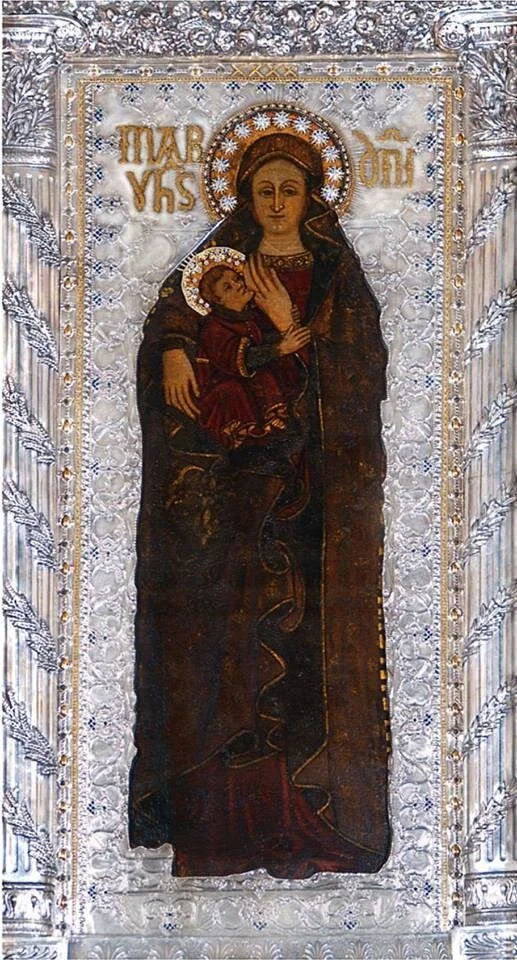Crotone
Madonna of Capo Colonna
Dawn of Peace
Original in the cathedral of Crotone, Via Pitagora 2, 88900 Crotone KR, copy in Capocolonna, her original dwelling place, province Calabria on the Southern tip of Italy, attributed to Luke, controversially dated anywhere from the 7th to the 14th century because the original wooden icon had to be transferred to a canvas due to woodworms damage.
Tradition says that Luke's icon of the nursing Madonna was brought to Italy by Dionysius the Areopagite, a Greek disciple of Paul, who became the first bishop and the patron saint of Crotone.
The image was installed in a church in Capo Colonna, 11 km from Crotone, near a sacred grove sheltering a famous temple of Hera Lacinia, a goddess revered as the protectress of women in childbirth. Since materials from this temple were used to build the cathedral in Crotone and a terrible earthquake hit this region in 1638, only a single column of Hera's temple remains standing. Still it's a beautiful site overlooking the Gulf of Taranto with the Madonna's little church nearby.
The original icon is now housed in the cathedral in Crotone, but a copy holds the place in Capo Colonna. Once a year the Madonna comes home for a visit on the cape. This occasion commemorates the miracle that blackened the Madonna and is celebrated with great festivities in May, the month of Mary. On the first day of the month the icon is taken down from the main high altar and placed in the nave. This makes the Madonna accessible to her children who respond by crowding around to kiss her. She is then carried in a comparatively short procession around town, stopping for a special blessing at the hospital. On the third Saturday a great crowd of faithful follow Our Lady in a much longer procession from the cathedral to Cape Colonna. Leaving around 1:00 p.m., they walk, many barefoot, about thirteen kilometers and arrive at the Cape around 6:30p.m. The night is spent with the Madonna and the local bishop at the cemetery. At the break of dawn the journey resumes, arriving at the old sanctuary with first light. Having spent one day at her old home, the Madonna returns to Crotone by night. This time she is transported by boat, accompanied by a fleet of fishing vessels lit up by torch light. As she enters the harbor of Crotone she is greeted by music and fireworks. The fishermen thus secure the Madonna's protection for their trips out to sea.
Mary's Festival of the Dawn continues throughout the month of May. Every seven years it is extra special. Usually a smaller copy of the actual holy image is taken on the pilgrimage, but then the life size original is carried in procession to Capo Colonna and back, foregoing the boat ride.
The earliest record of the Madonna in Capo Colonna stems from a 6th century manuscript entitled "The Book of Miracles". It mentions a small church in the town where the faithful venerate a sacred image attributed to Luke.
In 1519 the icon fell into the hands of Turkish pirates but was miraculously preserved. The thieves tried to burn it, but while the flames darkened the Madonna they would not consume her. The painting still shows a little scorching from the fire. Perceiving the power of this treasure, reminiscent of Moses' burning bush, the pirates decided to take it with them. But once it was on their ship, they were unable to move their vessel until they threw the Madonna overboard. She drifted to shore, where a fisherman by the name of Agazio lo Morello found her. He hid her in his cabin. Only on his deathbed did he reveal his treasure.
Countless other miracles have been attributed to the Dawn of Peace. She is said to have saved her town from the plague, calmed an earthquake, and healed many sick.


